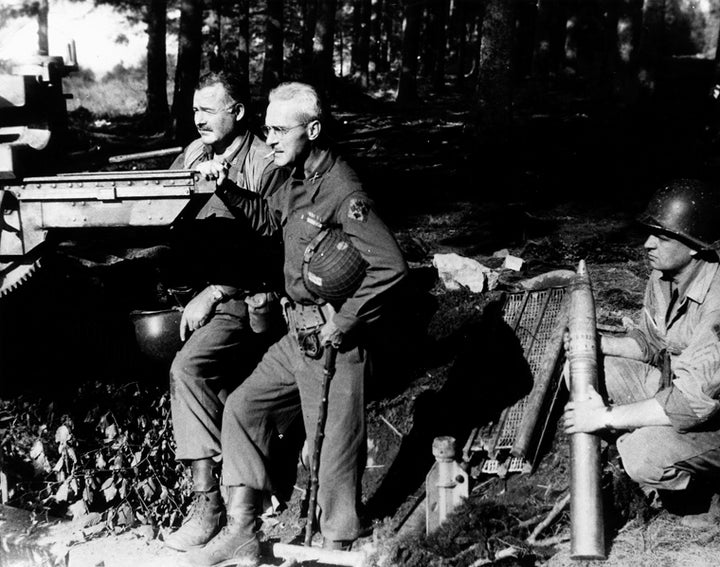
“Certainly there is no hunting like the hunting of man and those who have hunted armed men long enough and liked it, never really care for anything else thereafter.”
— Ernest Hemingway, “On the Blue Water,” (1936)
Chris Kyle, of American Sniper fame, was credited with 160 kills, a record which made him the deadliest military sniper in American history, surpassing the previous record of 109 confirmed kills.
But Ernest Hemingway might have challenged those records, according to his own accounts. The literary giant repeatedly told friends that he killed 122 enemy soldiers during World War II. If the author’s claims are to be believed, then the original American sniper might have been Hemingway, a Collier’s magazine correspondent who, according to the Geneva Conventions, was not even permitted to hold a weapon.
Yet, Hemingway regularly boasted to people such as Marlene Dietrich and Pablo Picasso that he had been wounded 16 times and had killed 122 men.
In October 1950, in a letter to author Evelyn Waugh (Brideshead Revisited), he wrote that the figure wasn’t such an impressive total, “especially for anyone who had ever have [sic] to teach sniping.”
Although Hemingway was an excellent and devoted hunter, there is no evidence that he ever instructed soldiers in the art of sniping.
Hemingway’s self-perpetuated image was often at odds with the historical record, not to mention common sense. Hemingway saw three wars—first, as an American Red Cross volunteer in World War I, then as a journalist during the Spanish Civil War and World War II.
Hemingway viewed D-Day operations on June 5-6, 1944 and transferred to the 4th Infantry by the end of July. He travelled back and forth from the front, until leaving for Cuba in March 1945. Hemingway’s greatest exposure to combat would have been Rambouillet in August, Belgium in September, and the Battle of Hurtgen in November.
As Hemingway grew comfortable with military leaders, particularly the 22 Infantry Regiment commander Buck Lanham, his non-journalistic activities during the war started to draw scrutiny.

On October 6, 1944, Hemingway was called before the 3 Army Inspector General following his actions in Rambouillet in late August when Hemingway “liberated” the Ritz Hotel with partisan. This interrogation led to the memorable exchange:
Inspector General: Were there mines in your room?
Hemingway: There were no mines in my room. I would greatly prefer not to have mines in my room.
In front of the Inspector General, Hemingway denied behaving as anything other than a journalist, which he later regretted. Even after this inquiry, Hemingway privately portrayed himself as an active participant in hunting “Krauts” in September 1944, during the Hurtgen Forest campaign.
In his private journal, Hemingway wrote that he had to shoot a German soldier “three times before he stopped.”
“I was in back of the pill box and I killed the one shot the one in back of us across the road in the woods about 15 yards,” Hemingway wrote.
It’s notable that he changed “killed” to “shot” in this passage, either opting for precision in description, or choosing a more conservative means of recording the experience.
When comparing “kills,” context is important. American sniper Kyle, whose own credibility has been called into question, nevertheless had 160 kills confirmed by the Navy in his 10-year career. By contrast, Hemingway claimed to have killed 122 “Krauts” in three months of intermittent engagement with the enemy.

After WWII, Hemingway began to include the number 122 in his work.
In Across the River and into the Trees, Hemingway’s first novel after the war, his dying protagonist Col. Richard Cantwell tells his young Italian girlfriend that he has, indeed, killed armed men: “One hundred and twenty-two sures. Not counting possibles.”
In his posthumous novel, Islands in the Stream, painter-turned-solider Thomas Hudson recollects the story of Colonel Crittenden and the 1851 expedition to Cuba, which resulted in a mass execution by the Spanish army. Hudson remembers, “they had shot one hundred and twenty-two American volunteers” against the hill of Atares in Bahía Honda. The number Hemingway chooses is striking, particularly when considering that the actual historical number of executed was 50.
But the first casualty of war is the truth, as Hiram Johnson pointed out. For Hemingway, the line between fact and fiction is a point of tension, both in his work and in his life.
Hemingway biographer Michael S. Reynolds wrote that the number of Hemingway’s wartime victims “increased in direct ratio to his drinking.”
Leicester Hemingway, Ernest’s younger brother, thought, “any number in excess of a hundred is really putting a gloss on it,” nevertheless allowing credence to his brother’s claim.
Hemingway’s son John was more noncommittal. “I suppose he killed some,” he said.
Charles Whiting — whose Hemingway Goes to War chronicles Hemingway’s World War II activities — was more critical. He derided Hemingway as “simply a tourist in a helmet.”
But it was perhaps Pablo Picasso who had the most insight.
When Hemingway and Picasso dined together after World War II, Hemingway presented Picasso with materials he had purportedly taken from a Nazi he had killed.
“He came to see me after the Liberation and he gave me a piece of an SS uniform with SS embroidered on it, and he told me that he had killed the man himself,” Picasso recounted. “It was a lie. Maybe he had killed plenty of wild animals, but he never killed a man. If he had killed one, he wouldn’t have needed to pass around souvenirs.”
Mark Cirino and Robert K. Elder are the co-authors, with Aaron Vetch, of Hidden Hemingway: Inside the Ernest Hemingway Archives of Oak Park. For more information, visit: www.HiddenHemingway.com.